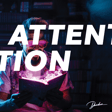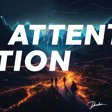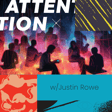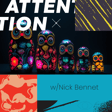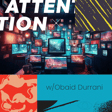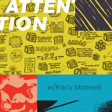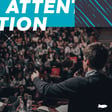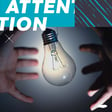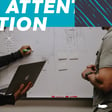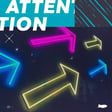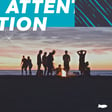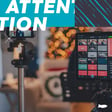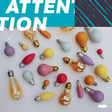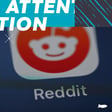Become a Creator today!Start creating today - Share your story with the world!
Start for free
00:00:00
00:00:01

From Lead Magnets to High-End Offers: Driving Revenue with Effective Content Transition
Welcome back to another episode of the Attention Podcast! In today's episode, we dive deep into the world of audience growth with our special guest, Candyce Edelen. She shares invaluable insights and strategies from her experience in hosting workshops, optimizing outreach on LinkedIn, and creating lead magnets that captivate and convert. So, let's jump right in and discover three actionable takeaways that will help you amplify your audience growth efforts.
Links Mentioned In The Episode:
- Candyce's lead magnets: https://propelgrowth.com/leadmagnets
Transcript
Introduction to Lead Magnet Strategies
00:00:02
Speaker
Welcome back to the Attention Podcast, where we learn how to gain and retain the attention of our buyers to build an audience. I'm Dan Sanchez, and today I talk to Candace Edelen about her lead magnet strategy, since I'm on this deep dive in this space. And she's using it to dominate events, how to extract all the best buyers out of an audience, getting them onto an email list, and then upselling them to either paid webinars or high ticket offers.
00:00:29
Speaker
she is crushing it with lead magnet so if you're in the events space doing live or virtual events and want to crush it with lead magnets you need to check out this episode but even if you're not we have a little conversation about the end about lead magnets and we debate some things back and forth she picks up she picked apart one of my ideas gave me some great suggestions at the
Effective Techniques and Real-World Applications
00:00:49
Speaker
end
00:00:49
Speaker
And remember to stick around until the very end where I have a separate little post-synopsis recording about my best takeaways from the interview. So, without further ado, here's Candace.
00:01:05
Speaker
So Candace, I'm excited for this conversation because I am on a journey to learn all about lead magnets and see how other people are just killing it with lead magnets. So right before this, I tapped record and we were talking about the pre-interview, you talked about essentially two different lead magnets you had going on that are working well for you. Tell me about the one that you're doing with events specifically and how those are working out for you.
00:01:27
Speaker
OK, so we've got a couple of different approaches that we're taking with events. One is live in-person events. So for example, I spoke recently at Denver Startup Week. That was huge. We got over 1,200 people registering for my two sessions between the two of them. And I don't get the list for that. So I've got to have a strategy to try to capture as many of those people as I can. So during my talk, I bring up
00:01:57
Speaker
Oh, by the way, I've got a workbook on that. And then I've got a particular slide that kind of shows my LinkedIn framework. And that comes early in the talk. And invariably, I see cameras going up trying to grab a picture of that LinkedIn framework. And I'm like, hey, hold on a second. I'll show you a QR code where you can download that.
00:02:18
Speaker
And at that same QR code, you can get a workbook and a couple of checklists. So then I show the QR code and all the cameras go up. So during those sessions, we brought in over 500 new leads just from those sessions because people wanted those assets. And then they go into our newsletter and start getting nurtured
Maximizing Engagement and Value
00:02:37
Speaker
from us. But there's also an automation that happens right after the download that helps them implement what we're teaching in that workshop or that session.
00:02:45
Speaker
That's fantastic. So how many, you're doing this in an event, you're dropping a little like, here's the thing. And then it's like way too much to consume in like the three seconds they have to view that slide. You're like, Oh, but if you want this for later, you know, go to this QR code, go to this URL where you fill out a form and you get the thing.
00:03:02
Speaker
I actually bring up that QR code multiple times in the talk. That's the first offer or tease is that framework. That was just because I saw people keep trying to take pictures of that framework and I'm like, I'll just make that a PDF and then they can download it and get a clean version of it. But then later in the talk, I talk a lot on LinkedIn and how to optimize how you're doing outreach on LinkedIn.
00:03:29
Speaker
As I know, you know, your headline is like the most valuable real estate on your profile. So I talk about that and talk about how to optimize it. And then I'm like, Oh, and by the way, I have a workbook that walks you through how to optimize your profile. Here's that QR code. It's the same QR code, but there's always people who missed it in the first one.
00:03:50
Speaker
And so then I bring it up at least one or two more times during the talk so that they all get it.
Advanced Lead Magnet Strategies
00:03:58
Speaker
And there's always the laggards that are coming up later with that with their cameras. So it's worthwhile to have it a few times. So you're putting multiple lead magnets within one talk. Yeah. How many usually?
00:04:11
Speaker
It used to be just two. We added a couple more recently because we had them and we're like, hey, we could actually add this checklist and just increase the value of that. We're still testing that to see whether people are actually grabbing all of the things or if they're just grabbing that workbook. The workbook I know they're grabbing because they'll reach out to me on LinkedIn and say, oh my gosh, that was really helpful.
00:04:35
Speaker
So it's a workbook, a checklist, and what else? And the framework. So two checklists and then the framework. And they're pretty simple things. I mean, honestly, the workbook feels really valuable to the prospect, but it's three pages. It's got a few sample headlines and a few templates for how to lay out your headline. But it's not anything that's like,
00:04:59
Speaker
I would not give them a 50 page thing because that's overwhelming. I just want them to have something small that they can work with and actually get something accomplished.
00:05:08
Speaker
Yeah. And that makes a ton of sense. And so it's three things. You have three unique QR codes or just one QR code? One QR code. Sorry, I like to get into the nitty gritty. No problem. One QR code, they fill out the form. You deliver all three at once. And this is really important, Dan, on that form. You got to keep it simple. Don't give them a lot of other content on that page because you don't want to distract them from your talk.
00:05:33
Speaker
So i had a marketing support person that wanted to put a video on that download page and i'm like no no no no no because i'm watching the video it's just live i'm in front of them and i want their eyes on what i'm teaching and their attention on what i'm teaching so it's a really short.
00:05:52
Speaker
page. And it's interesting because we'll get a lot of lagging registrations for that. So, you know, like I'll get if I have 200 people in the room, I'll get probably 60 or 70 people will register right away. But then we'll continue to get them. I'm still getting things. Denver Startup Week was four weeks ago, and I'm still getting registrations today.
00:06:13
Speaker
Wow. So is there something you do with your slides to make it more compelling? So for one thing, like the infographic or the, the, what is it? The framework you're using, I'm guessing is very visually intensive enough that you can't just, it's, it's not so simple, like a Venn diagram where you're just kind of like, Oh, okay. I get the concept. It's, it's robust enough that people are like, Oh, I need to study this for at least 10, 15 seconds. I want to look at this later because I'm going to forget.
00:06:39
Speaker
And it's not perfect, but people really value it. So it shows the three, kind of like I think of LinkedIn as a three-legged stool where you've got your profile and creating credibility. So the top thing says credibility on that. Then the next leg of the stool, the center is visibility. So what are you doing with posting and commenting? And then the third leg is relationships. And each one has like, I think six bullets underneath it about what you need to do. So it's visual, it's attractive.
00:07:05
Speaker
And it also has details on it that they can't just jot down quickly. And I don't leave the slide up very long. Nice. So that's a good strategy for app person events. Are you also doing the same thing for virtual events? So there's two different kinds of virtual events that I do. There's the ones that I'm hosting.
00:07:29
Speaker
And there's the ones that somebody else hosts. So for the ones that I host, I usually will, I've already got their email address. And so I will actually offer a workbook ahead of time for them to get some ideas so that they're more engaged during the live workshop. And then we'll offer it again after the workshop so that they can continue to do work on whatever it was that I was teaching in that workshop.
00:07:53
Speaker
And we'll come back to that because I want to talk about the paid workshops also So the second option is I try to do live events I mean live virtual events with partners all the time because they've got a list and I want access to their list now There's two different ways to approach this one is my favorite is that we'll host the registration page and
00:08:17
Speaker
Now I've got all of the list, you know, they email it out, but I get, I collect the registrations. Sometimes they don't want to do that. And so then I have to have a new way of capturing those leads and I go back to my QR code methodology. But when it's online, two things, one is it feels like the QR code is redundant because we're going to throw it into chat as well with the link. However, I've learned that it's really important to include the QR code for the recording.
00:08:46
Speaker
because they'll put up the recording on their site and I'll be getting registrations from that QR code for a year. I mean, it's not like a lot, but they still come through. And if I hadn't put up the QR code, if I had just done it in the chat, they wouldn't get that link.
00:09:02
Speaker
interesting is if you're doing enough of those, then that trickle effect is start adds up, right? Because they're trickling in from each one. And if you have 10 of those fishing poles out out in the sea, then well, you're kind of pulling things from all of them all the time, then right exactly. And for the most part, the the lead magnets themselves are pretty similar.
00:09:20
Speaker
We don't have a ton of them. We just try to reuse and repurpose the same ones because we're talking about these specific topics over and over again. So there's not a need for me to go create endless numbers of lead magnets.
00:09:33
Speaker
Yep. So you're doing in-person events. You're doing virtual events. Some of them are your virtual events. Some of them are other people's virtual events where you're using this material. Tell me about these paid events. Are you using free events to get people to paid events? Or are you just promoting the paid events on social? And do you consider a paid event to be a lead magnet?
00:09:52
Speaker
Yes, yes, yes, yes, yes. All of those are yes. Yes, Ann. Sorry, I'm stacking my questions. I love it. I love it. OK, so I took a course from a company called Wake Up to Freedom. It's called Mini M-I-N-I Workshop Magic. And that has been magical in terms of just kind of thinking through how to do this. And they teach this idea of doing small paid workshops
00:10:20
Speaker
that you can use as a lead magnet, but also as a way to get somebody paying a little bit of money for your services. Because once they've paid a little bit, they're much more likely to convert to paying for your higher dollar ticket items. And so I have found that to be true. I find that we get
00:10:41
Speaker
I mean, our high-end offers about $7900 and our workshops are about $37. And I get about a 12 to 18% conversion. So it really is a much higher conversion ratio than you're going to get on a free thing. Wait, how much is your bigger ticket item? $3700? $7900. Oh, $7900. OK. Yeah.
00:11:07
Speaker
That's a massive jump. What? So sorry. Tell me, I'm like running the numbers in my head. How many people are you getting to these paid mini workshops?
00:11:14
Speaker
So we will usually get between 40 and 80 people to do a paid workshop. Now the conversion to our higher end product is not immediate. Um, our sales cycle is oddly really long. Um, even though it's not that expensive, it's a couple of years. So I'm still seeing conversions of people who joined one of our paid workshops in December of 2021. How long is your, so it's a couple of years. Why is it so long?
00:11:44
Speaker
It's a year-long program. What we do is we run a prospecting accelerator to help people get better at LinkedIn prospecting. And we work with a lot of small companies and solopreneurs, especially in the Microsoft reseller space.
00:12:01
Speaker
And what I find is that they need to have circumstances right in their business to get the most out of the training that we provide. Like, you know, we've had people where they were ready to join and then a key member of their staff quit. And so if they're a small business owner, they've got a lot of plates they're spending anyway, and now they got to go pick up
00:12:25
Speaker
the plate for that key staff member. So that's not a good time for them to join an accelerator that's gonna bring new business into their company.
00:12:34
Speaker
And so I'm pretty careful with the people that join our accelerator to make sure that the timing is right, where they can devote the time and attention and accommodate the new business that's gonna come in as a consequence of it. And so I think that's a large part of the reason for our longer sales cycle is their readiness. And I like to push people, it's stupid to push people in early because then they're not gonna get the value from it.
00:13:03
Speaker
Yeah. Um, so what's the conversion ratio between you said you're getting 40 to 80 and what percentage of people are you getting to convert over? So we have a couple of other intermediate offers and between all of them, it's about an 18% conversion from early stage paid offer to some other paid offer that we're off. We have gotcha.
00:13:23
Speaker
All of them combined, but you don't know what the webinar one is specifically. Still working on all of those numbers. It's hard. Well, especially when it's so long in between, right? It's hard to track that conversion, right? But still, 18 overall is pretty good. Yeah. How many of these webinars are you doing a month? Are you doing a paid workshop a month?
00:13:43
Speaker
No, we're doing it about not quite once a quarter, two, three, maybe four times a year. We did three of them over the summer, well, between summer and end of September, but that was because we had a couple of sponsors that wanted to get behind it.
00:14:01
Speaker
they bring all of the audience and I split the revenue with them. They don't really generally care about that because they really want their audience to get these workshops. But to me, it's a good way to create that, you know, it's like we're in this together and then they do the promotion to their audience. So we did a couple of those this year too. So the jury's still out on
00:14:25
Speaker
whether those will convert as well as our previous ones, just because we're not two years from those yet. Yeah, that makes sense. But I always look at everything I'm doing is pipeline building for like a year or more out. I don't gauge the success of a marketing strategy based on whether I made a bunch of sales the next month. That's unrealistic.
00:14:52
Speaker
A tip for any marketer listening to this right now. I feel like most marketers are hamstrung because they're expected to produce that quarter. And I keep trying to tell people, I'm like, look, you're killing yourself trying to pick up the bottom of the barrel in one quarter. When you could be sowing seeds, it becomes easy to reap next quarter or a year from now. Yeah, you hear those. That's not how most people live.
00:15:17
Speaker
I'm hoping we can give them a tool to take to their bosses in this conversation because you hear all the time that it's like if any given target market, 3% of your target market is in market for looking for solving the problem that you help solve. Event strategy and a lot of the inbound things that we are doing are actually going after the 97%.
00:15:43
Speaker
And that's good because we can nurture them and the close ratio on when you create vision for someone rather than them coming to you with a vision already established, the close ratio is significantly higher. I've heard estimates from
00:16:00
Speaker
Gartner and the corporate executive board and RAIN Group have all done research on buying processes in the B2B space that it can increase your close ratios by 70%. So it's really worthwhile to nurture long term.
00:16:14
Speaker
They just don't. Do you know where that research is? I see 3%, I see 5%. Just to be safe, I say 10% of the markets ready to buy within a quarter. The only research that I've seen done on it was from LinkedIn, but I found it once and couldn't find it again, where they said maybe their data said 7% was in market per quarter, which means over the course of four quarters, you're looking at 28% over the course of a year as a market. Highly unrealistic.
00:16:44
Speaker
I don't think that it depends. Of course, it varies from industry and product and what you're selling because some people are always in the market for let's say you're selling just computer stations or laptops now since we're in remote worker era. You have a certain amount of turnover of
00:17:00
Speaker
laptops. So you're going to be in market for laptops. So you have a vendor that supplies you those. So those things are reoccurring, but then some things like Salesforce subscriptions is kind of like CRMs only get changed over so often. Yeah. And there's a long period of time where people have to be experiencing extreme pain before they're ready to actually go through the extreme pain of switching.
00:17:25
Speaker
I just haven't seen the data that supports three to 5%. I just, it's general word of mouth. I think it's word of mouth. Yeah. It's kind of like the goldfish memory. How do you measure the memory of a goldfish? So I say 10% just to be, just to give it safe, but even 10 to 90 is kind of like still a ridiculous stat. You're like, okay, let's just say it's 10 and maybe another 10% next quarter. You're still missing out like 80% because you're trying to fight for that 10 or 20%. Right.
00:17:51
Speaker
Yeah, and that's that if you've done Blue Ocean Strategy, if you've read that book, it's phenomenal. You know, you're fighting in the red ocean if you're only fighting for those deals that are ready to convert now. And you haven't, unless you're really, really good at nurturing and
00:18:10
Speaker
have been nurturing them for two years, you didn't set the vision for them. Somebody else created the buying vision. And so then you're just like struggling upstream to try to change their mind about their buying vision in order to buy your stuff instead of the original company that has been nurturing that.
00:18:27
Speaker
Yeah. So I think I like that book and I think that same metaphor carries, but the book is about something different because they're talking about positioning and category of products versus we're talking about timing, right? Right. Like his timings timings, the essence that's creating the blue, the blue and the red versus the future. The future is the blue. The current people that are in market right now is the red.
00:18:49
Speaker
You're right, you're right. I'm concatenating ideas here. Oh, still, I don't know, I've used it before. We're fighting in a red ocean, fighting over the three to 10% that are in market right now. Yeah. Better to go upstream and throw a net way up there before it even gets downstream, and then you can capture way more. Or to that lead early, yeah.
00:19:13
Speaker
Yeah, I love Chris Walker says whoever generates the demand gets to keep it. So if you can generate demand for your thing way ahead upstream where the fish are still coming down, then you get to like the likelihood that you're going to catch them and they have an irrational bias for your thing versus your competitors. We're not at all is through the roof way higher. Yeah. So that's the point. And that's why it affects the close ratios.
00:19:39
Speaker
because they're already biased toward you. I think that's the point. We're trying to create bias.
00:19:47
Speaker
Yep. And that's why lead magnets has been the thing that I've been getting on recently, only cause like Alex Hermosi has been like tearing up the business role. They recently launched this book, a hundred million dollar leads. I'm, I'm a huge, I read a lot of marketing books. There's multiple sub topics within marketing where I've read all the books. You could see like, this is part of my bookshelf. The other ones on the other side, but they're even color categorized. Oh yeah. So easier. I remember the colors better than I remember the title sometimes. So I'm like, where was that book? Oh, it was orange.
00:20:15
Speaker
Now I remember to find it. I don't know what it is. I'm a visual person. That's brilliant. But I read a lot of books. This is the best book I've read on marketing today. I had my favorites. This one's become my number one. He emphasizes lead magnets. He has a great framework for lead magnets, but still, as robust as the book is and as perfect as the book is,
00:20:37
Speaker
there's still so much more to know. He doesn't have specific recommendations of lead magnets. He has frameworks for it of categories of lead magnets, but I wanted to get down into the nitty gritty. That's why we're talking about yours today. How many lead magnets does he recommend? Do we have enough or should we have more?
00:20:56
Speaker
He, when I read his guide on lead magnets, I was like, Oh my gosh, I've done lead magnets before, but he's clearly playing like Olympic level game here. And I'm playing like JV volleyball. I have a lot to learn. Gosh, I wasn't really prepared for this, but, uh, he's got a few different categories here of lead magnets. See if I could find one. I'm having a hard time pulling it up.
00:21:24
Speaker
But let me give the overall framework that blew my mind was the fact that he has like a he makes a grid of
00:21:35
Speaker
lead magnets and he has a cross of three and four different categories that he crosses together to make 12 and he'll make 12 lead magnets probably not in every single category because some of it's like if you're selling I don't know like a new food item like a sample is a lead magnet hence Costco you think of like Costco samples lead magnet it's called trying before you buy that's why the Costco sells so much more of their new stuff um lead magnet you can't do that with the software product it's I don't know to try to like
00:22:06
Speaker
I guess the freemium model would be a sample of it or a trial rate or free trial. Yeah. So you try to think about how you can do it. Um, so he takes all the lead magnets and then runs ads against all of them. Finds out which is the three best perf or the best performers like getting the most clicks. And then he optimizes each one of them first with the headline. Then the image. No, I think it's image first is the biggest thing he, he noticed has a significant list image headline.
00:22:32
Speaker
No, sorry. Headline, image, body copy. That's the order you tested in. But I'm like, oh my goodness. If you take, and he specifically targets the pain they're feeling that maps best to what you sell. So I said, if you could small just a small chunk of the pain that they're feeling, and use a league magnet to offer a complete solution for that small chunk of the pain for just one piece of the problem,
00:23:01
Speaker
That's a lead magnet, a good lead magnet. That aligns perfectly with my paid workshop strategy. You want to try to help them get one item off of their to-do list done, and that's the goal of the workshop. You're not trying to boil the ocean with them, just help them get one thing done. Just one little piece. Yeah, so I can see how that would work well with the ad strategy, and a paid workshop starts paying for the ads, too.
00:23:28
Speaker
So after I read that, I was like, oh shoot, what are all the possible lead magnets I can run? I went and just took inventory on the internet of all the 15 best lead magnets, 50 lead magnets. Here's a hundred ideas. And I just went and pulled them all into one massive list to create a database of them. As I reviewed them all, like there's all kinds of lead magnets. But after talking to a few people who are doing well with lead magnets, it's become obvious that the ones that are usually the best performing are the ones that are the easiest to consume.
00:23:55
Speaker
So checklists, workbooks. If you give them an ebook, it's going to be a fail because they're not going to consume it. Shoot, even today I just moved, I just cleaned off my desktop and moved a lead magnet that was just too long into a folder somewhere. I'm like, where did I put that? I'm like, we think we're creating value. I have three other lead books. I have three other books in here that I've downloaded at some point that I still haven't read. I can't throw it away because I want to read it, but it's too long.
00:24:25
Speaker
Because who reads eBooks on their computer? Nobody. And nobody got time for that. It doesn't matter how good the value prop is. No, no. And we think that we're giving them more value by giving them longer stuff, but in reality, we're just preventing them from reading it.
00:24:44
Speaker
So the best ones are easy to consume. I've started finding and what I'm experimenting with them, like, can I make it really easy to consume and then bundle it with other things? So technically it's actually a mini course and I can reframe it to be multiple things and then advertise it and position it as a bunch of things all at once to figure out what the best frame is. Like I found out like a checklist, for example, I made an audience growth checklist.
00:25:07
Speaker
I bundled it with videos on how to look at the checklist and how to evaluate each of the categories within the checklist. Each checklist item is a question, so it's also a questionnaire. I could easily turn it into a workbook. It's also because I built it in Google Sheets, it's also a scorecard because as they check things off, it has a little score.
00:25:26
Speaker
on it. I could call it maybe a benchmark report if I just ran through the checklist and through with a couple companies, you know, and just like gave them scored a couple of well-known people within certain industries and now they would be a benchmark report. So I'm like, how else can I use this in order to like add value to this one lead magnet that's still really easy to consume at first glance, but then has layers to it as people go deeper.
00:25:50
Speaker
That's kind of where I'm like, can I make an ultimate lead magnet? That's highly consumable, but still incredibly deep. If they want to go deeper, that's kind of experimenting with now. I would flip that script a little Dan start with the checklist, which is brilliant. And then sell the other things rather than offering them for free, because people don't value what you give them for free. No matter how valuable it is, it's not valuable to them.
00:26:16
Speaker
Sell it like a tripwire, like a $7 thing or a $30 thing? Yeah, like for example, okay, now you got this checklist, would you like some videos on how to implement this? Click here and seven bucks. Or you've downloaded these videos, would you like a workshop on, we recorded a workshop on how to use them, would you like that? And if they've bought more than one thing for you,
00:26:41
Speaker
Again, they're much more likely to buy your high-end offer. So they're not going to value it if they don't pay for it.
00:26:52
Speaker
That's true. I, it's funny because I thought for a long, I mean, I've made multiple courses now. I was going to give them all away for free and I did. And then I realized one, it's harder to get people to even consume the material. If it's free, it's hard. It's hard to get people to consume courses. Even if you charge for it. True. I don't know what it is. I'm like, people buy $200 courses and then don't watch it. Yeah. Yeah. That blows my mind because if I'm to me, $200 is a lot of money. I'm not going to spend 200 bucks if I'm not going to use it.
00:27:22
Speaker
$37 I might, but even then I value that. It's like our mentor. So in Fort Collins and in different parts of Colorado, they've gotten rid of plastic bags. And if you want a bag, you have to pay for it. And it's 10 cents for the bag. It's not expensive, but there are so many people leaving the grocery store with a cart full of groceries because they forgot to bring their bags in and they don't want to pay the 10 cents for the bag. Yeah.
00:27:51
Speaker
So if you take that in that reverse psychology, people are more likely to value something if they've paid for it.
00:27:58
Speaker
Yep. So I've started charging for my courses. I still don't sell like a lot of courses. I get a trickle in of those, but I still have to figure that out and connect it from the lead magnet on, but you're right. I probably should test like making less out of the lead magnet, but I don't, I'm trying to get someone to go from lead magnet to high end offer. And what I'm doing is I'm, instead of going from lead magnet to low end offer, I'm usually going to the landing page on the lead magnet to a.
00:28:27
Speaker
a high-end offer pitch of some kind. I'm trying to get them to go into what is essentially a second lead magnet that is a free consultation and audit that leads to a pitch of some kind. So it's a value-added sales pitch, essentially. So they walk away with something in the sales pitch, but we're going to do an evaluation to make sure to see if it's a good fit for you to work with us on a high-end level. That's kind of what I'm experimenting with now, lead magnet to that.
00:28:55
Speaker
We've been experimenting with these paid workshops and then an upsell off of the paid workshop for one-on-one consulting with me. I haven't gotten a lot of people buying that, which is interesting. I don't charge a lot for it. And we've experimented with everything from $250 down to $47.
00:29:16
Speaker
You can see I like random numbers. But I also, there's a strategy behind that because I know that if they paid 37 or 57, they bought a mini workshop because we have an early bird price of 37 and then it goes up to 57. If they paid $56, that's an order bump workshop that they can add to it. So it's like, I know these things and I've kind of got a log of what our price points are and what types of offer they then bought from it. And that's been interesting off of the,
00:29:46
Speaker
the $37 workshop that will be a live event, well, I mean live virtual, they can buy an order bump, which is a recorded video that's a companion course. And I usually sell about 20%. We'll take that order bump.
00:30:05
Speaker
Do you think it's worth it for B2B companies that maybe have a high end software or a high end service of some kind? And these are relatively large companies that have like these little mini priced items in order to
00:30:19
Speaker
enhance their marketing. So I've noticed most big B2B companies don't do that. They don't have $37 items. They don't have $200 courses. Creators do. What like solopreneurs or people with like an administrative assistant, like you have two, three employees. Two and a half. So this is normal in our industry is almost like I'm solo too. So that's pretty normal, but I don't see big companies do this hardly ever.
00:30:47
Speaker
I wonder because I used to do marketing for bigger companies before we shifted over to the LinkedIn training model and I'm of the opinion that they would be able to create a far more qualified list for their salespeople if they tried that. We've done things where
00:31:11
Speaker
I mean, the company sponsored it, so it wasn't something that people paid for, but they had to travel to do it. We've done live roundtables.
00:31:18
Speaker
in person where we'll bring, like this company was selling software to facilitate creating fact sheets. The things when you invest in a particular mutual fund or a stock, you get these sheets that describe it. So their company produces those. They have software that produces those and all the other stuff that you get dividend reports and things like that.
00:31:42
Speaker
And so we brought together all of the different asset managers, clients, and prospects into an in-person roundtable that was a half-day event. That proved to be a really effective way to engage and build trust with those prospects, but we didn't ask them to pay anything for it. And I just wonder
00:32:04
Speaker
What would have happened if we'd asked them to pay? They were super engaged. They were super interested in it. It went well. But I just wonder, would we have seen a higher acceptance rate of people coming if they had to pay? And would we have seen a higher conversion to them buying the software? We didn't advertise or pitch the software in the
00:32:26
Speaker
event. We were really talking about problems that marketers are dealing with and, and just giving these marketers an opportunity to come together at the table and meet each other. But, um, I do wonder about those things. Like what if we charge 50 bucks for it? Yeah.
00:32:42
Speaker
Oh, you've given me a lot to think about going back. I'm wondering if I need to unpack unbundle my checklist thing a little bit I Can't wait to hear what you decide to do with that. Yeah. Yeah. Well, it's gonna take some time to test it and figure it out. So If you're listening to this I'd love for you to reach out to us on LinkedIn Send us a DM. Tell us your thoughts and if you have a counterpoint to this DM me we might do a show
00:33:09
Speaker
Woo! That was a good interview. I am especially excited about getting some contrary opinions, some pushback to some of the ideas I've had about bundling goodness into lead magnets. It's always good to get feedback from other people who have been there and done that.
00:33:25
Speaker
And I thought adding more value to a lead magnet might be a good thing, but maybe separating it out and charging a little bit for it might be the best thing. So now I got some more stuff to test and I'll, if, if you want to find out how those tests go, like subscribe to my newsletter. It's the most likely place where you're going to find out about it later. Um, go to danches.com slash newsletter. But if you want access to some of the lead magnets that Candace was talking about, she actually drop is making a custom link for you guys to go grab all her lead magnets and walk
00:33:54
Speaker
through the process of what it's like to see a lead nurturing system afterwards. Cause that's important part that we're not covering in this series is the automated sequence that happens, but it's still a vital part for lead magnets. So if you go to propel growth.com slash lead magnet, you could see Candace's lead magnets. And what is a good example of what kind of lead magnets you and I should be creating in order to build trust with our ideal buyers and lead them by the hand.
00:34:19
Speaker
towards more value to get more out of it for their business, but also towards working with us in a paid capacity, which is the whole point of lead magnets is to solve bits and pieces of their problems. Um, so they can learn to trust us, to like us and get, get a sample of the value that we can add so that they know we can add way more value in a paid relationship.
00:34:40
Speaker
So that's my takeaway. I got some work to do on my own lead magnets. And trust me, you're going to want to go to propelgrowth.com slash lead magnet in order to check out hers. If you're on LinkedIn, then it's probably going to be really helpful for you anyway, because that's what she



